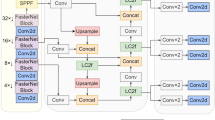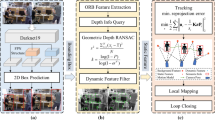Abstract
This study aims to develop a three-dimensional image reconstruction method based on the Laser Line Scan (LLS) technique to establish the binocular stereo-vision system for the preliminary research of obstacle detection technique of Autonomous Underwater Vehicle (AUV). A coordinate mapping relationship between 2D pixel coordinate and 3D world coordinate, which can be used to reconstruct 3D objects from 2D scan data, is established by means of direct camera calibration in air and water. In the experiments, the target object was originally designed by Computer-Aided Design (CAD) model and fabricated by the 3D printer. Subsequently, the qualities of point clouds acquired from the target object would be analyzed and compared in the stability water tank at National Cheng Kung University. The acquired point clouds would be used for polygonal surface estimation of the target object by Bonjean curve fitting method in water, with the reference results in air. The acquisition of raw point clouds has been accessed via the transformation to grayscale, histogram equalization, image binarization and skeletonization thinning. Consequently, the results evaluated by our stereo-vision system indicate the reliability and performance in the stability water tank before the application to the obstacle-avoidance of the AUV.







Similar content being viewed by others
References
Fang M-C, Wang S-M, Wu M-C, Lin Y-H (2015) Applying the self-tuning fuzzy control with the image detection technique on the obstacle-avoidance for autonomous underwater vehicles. Ocean Eng 93:11–24
Bythell JC, Pan P, Lee J (2001) Three-dimensional morphometric measurements of reef corals using underwater photogrammetry techniques. Coral Reefs 20(3):193–199
Gracias N, Santos-Victor J (2000) Underwater video mosaics as visual navigation maps. Comput Vis Image Und 79 (1):66–91. doi:10.1006/cviu.2000.0848
Canciani M, Gambogi P, Romano FG, Cannata G, Drap P (2003) Low cost digital photogrammetry for underwater archaeological site survey and artifact insertion. Paper presented at the The International Archives of the Photogrammetry, Remote Sensing and Spatial Information Sciences
Foresti GL (2001) Visual inspection of sea bottom structures by an autonomous underwater vehicle. IEEE Trans Syst Man Cybern B 31 (5):691–705. doi:10.1109/3477.956031
Remondino F, El-Hakim S (2006) Image-based 3D modelling: a review. Photogramm Rec 21 (115):269–291
Blais F (2004) Review of 20 years of range sensor development. J Electron Imaging 13(1):231–243. doi:10.1117/1.1631921
Jaffe JS, Moore KD (2001) Underwater optical imaging: status and prospects. Oceanography 14(3):64–75
Kocak DM, Caimi FM (2005) Tie current aft of underwater imaging—with a glimpse of the past and vision of the future. Mar Technol Soc J 39 (3):5–26
Wang CC, Cheng MS (2007) Nonmetric camera calibration for underwater laser scanning system. IEEE J Ocean Eng 32(2):383–399. doi:10.1109/Joe.2006.880391
Yang Y, Zheng B, Kan LY, Yu J, Wang JC (2014) 3D color reconstruction based on underwater RGB laser line scanning system. Optik 125 (20):6074–6077. doi:10.1016/j.ijleo.2014.07.072
Leone A, Diraco G (2006) Distante C Stereoscopic system for 3-d seabed mosaic reconstruction. In: International conference on image processing, pp 11541–11544
Harvey E, Shortis M (1995) A system for stereo-video measurement of sub-tidal organisms. Mar Technol Soc J 29 (4):10–22
Gupta M, Narasimhan SG, Schechner YY (2008) On controlling light transport in poor visibility environments. Paper presented at the Conference on Computer Vision and Pattern Recognition, Anchorage, AK, USA
Murino V, Trucco A (2000) Three-dimensional image generation and processing in underwater acoustic vision. Proc IEEE 88 (12):1903–1946. doi:10.1109/5.899059
Lee HS, Kwon SH (2003) Wave profile measurement by wavelet transform. Ocean Eng 30 (18):2313–2328. doi:10.1016/S0029-8018(03)00114-8
Xu CY, Prince JL (1998) Generalized gradient vector flow external forces for active contours. Signal Process 71 (2):131–139. doi:10.1016/S0165-1684(98)00140-6
Wright MW, Fallside F (1993) Skeletonisation as model-based feature detection. IEE Proc-I 140 (1):7–11
Chen RKaL-F (1991) Iterative neural networks for skeletonization and thinning. Society for Optical Engineering
Hall Z (1991) Fast fully parallel thinning algorithms. CVGIP-Image Understanding
Tseng K-MHC-CMC-G (2002) A digital image processing method for isochromatic fringe sharpening of photoelasticity. National Taiwan University of Science and Technology
Fang M-C, Wang S-M, Mu-Chen W, Lin Y-H (2015) Applying the self-tuning fuzzy control with the image detection technique on the obstacle-avoidance for autonomous underwater vehicles. Ocean Eng 93(0):11–24. doi:10.1016/j.oceaneng.2014.11.001
Huang L-C, Lin Y-H (2016) The Development of Underwater Inspection Technique Applying Image Navigation Mode. J Taiwan Soc Nav Archit Mar Eng 35(1):39–47
Faugeras O (1993) Three-dimensional computer vision: a geometric viewpoint. MIT Press
More J (1977) The Levenberg-Marquardt algorithm, implementation and theory. In: Watson GA (ed) Numerical analysis. Springer
Brown DC (1971) Close-range camera calibration. Photogramm Eng 37 (8):855-866
Tsai RY (1987) A versatile camera calibration technique for high-accuracy 3d machine vision metrology using off-the-shelf Tv cameras and lenses. IEEE J Robot Autom 3(4):323–344
Wei G, Ma S (1993) A complete two-plane camera calibration method, experimental comparisons. In: Fourth international conference on computer vision, Berlin, pp 439–446
Zhang TY, Suen CY (1984) A fast parallel algorithm for thinning digital patterns. Commun ACM 27 (3):236–239. doi:10.1145/357994.358023
Davis LS (1975) A survey of edge detection techniques. Comput Graphics Image Process 4 (3):248–270
Bougnoux S (1998) Sixth international conference on computer vision. IEEE, Bombay, pp 790–796
Harris C, Stephens M (1988) A combined corner and edge detector. In: Fourth alvey vision conference, Manchester, UK, Plessey Research Roke Manor, pp 147–152
Bouguet J-Y (http://www.vision.caltech.edu/bouguetj/calib_doc/) Camera Calibration Toolbox for Matlab. MRL-Intel Corp
Zhang ZY (2000) A flexible new technique for camera calibration. IEEE Trans Pattern Anal 22 (11):1330–1334. doi:10.1109/34.888718
Bruno F, Bianco G, Muzzupappa M, Barone S, Razionale AV (2011) Experimentation of structured light and stereo vision for underwater 3D reconstruction. ISPRS J Photogramm 66 (4):508–518. doi:10.1016/j.isprsjprs.2011.02.009
Acknowledgements
The authors would like to express their thanks to the National Science Council for a grant under Contract No. MOST 104-2221-E-006-190. The authors also thank the great support for this work provided by Research Center for Energy Technology (RCETS), National Cheng Kung University. The partial support coming from the International Wave Dynamics Research Center (IWDRC), National Cheng Kung University, for a grant under Contract No. MOST 104-2911-I-006-301 is very appreciated. The research was, in part, supported by the Ministry of Education, Taiwan, R.O.C. The aim for the Top University Project to the National Cheng Kung University. Besides, we would like to appreciate the precious comments from Prof. Ming-Chung Fang during the research period.
Author information
Authors and Affiliations
Corresponding author
About this article
Cite this article
Lin, YH., Shou, KP. & Huang, LJ. The initial study of LLS-based binocular stereo-vision system on underwater 3D image reconstruction in the laboratory. J Mar Sci Technol 22, 513–532 (2017). https://doi.org/10.1007/s00773-017-0432-3
Received:
Accepted:
Published:
Issue Date:
DOI: https://doi.org/10.1007/s00773-017-0432-3




